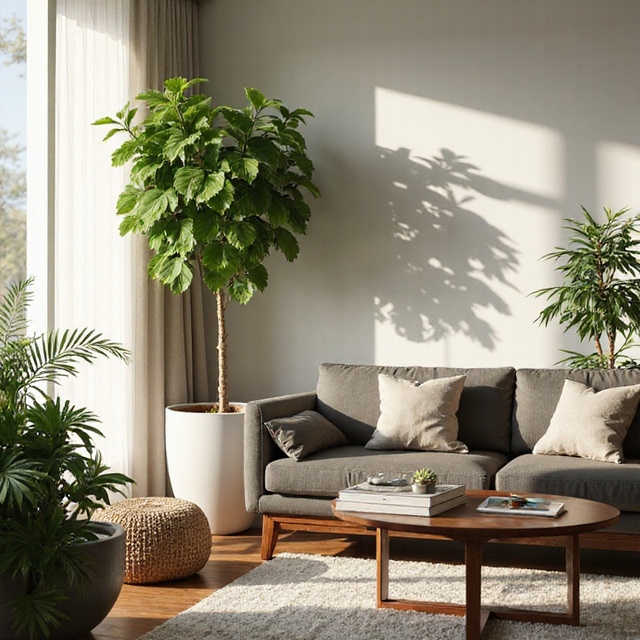
Transform Your South African Home with Stylish and Low Maintenance Artificial Plants
If you’ve ever tried growing a houseplant in Joburg winters or Durban's steamy days, you’ll know it isn’t always as zen as Pinterest makes it out to be. That’s where artificial plant décor steps in — lush, low-maintenance, and (when done right) completely believable. Whether you're styling up a new flat in Sandton or giving your Pretoria stoep a refresh, faux greenery adds that splash of life with zero fuss.
Key Takeaways
- Artificial plants remain stylish, especially when mimicking trendy varieties like fiddle leaf figs and monstera.
- High-end options can last 5–10 years, with UV-protected types suited for outdoor patios or balconies.
- They’re ideal for pet owners and busy homeowners — non-toxic, tidy and no watering necessary.
- Use artificial plants to decorate every room — from bonsai on your bedside table to palms brightening up your lounge.
- Cleaning is easy: just a gentle wipe with a damp cloth or feather duster will do.
Curious about how different artificial plants might look in your space? Try out our interactive décor matching tool below:
Why South Africans Are Embracing the Faux Foliage Trend
From Cape Town to Polokwane, artificial plants are making their way into homes, Airbnbs and designer offices alike. Why? Because they bring the look and feel of greenery without worrying about watering schedules, sun exposure, or replacing wilted leaves. Especially in places like PE or Bloem where seasons can be unforgiving, these beautiful fakes thrive where real plants don't.
Style It Like a Pro
Want to create a chic, fresh look? Pair artificial flowers with modern ceramic vases — something like the Green Rustic Ceramic Vase adds major character. Position taller greenery in room corners, and use trailing varieties over shelves or fireplace mantels. Don’t forget to vary pot heights and leaf textures for a more organic feel.

Are Artificial Plants Better Than The Real Thing?
We’re not knocking real plants — they’re glorious when they’re healthy. But busy lifestyles, limited natural light, and curious pets make them less practical for many South Africans. The truth is, high-end faux plants made with PolyBlend and treated with UV protection hold their colour and form for up to a decade. That’s major long-term value.
“Opted for an artificial olive tree from Future Decor for my living room — visitors keep asking where I bought the ‘real plant’!” – Naledi, Sandton
“As a pet owner, I had to toss most of my real plants. Switched to faux and haven’t looked back — my kitty can chew in peace!” – Denzil, Durban
Where to Place Artificial Plants in Your Home
| Room | Recommended Plant Style | Why It Works |
|---|---|---|
| Living Room | Fiddle Leaf Fig / Monstera | Makes a statement and fills larger spaces |
| Bedroom | Bonsai / Bamboo | Soft, calming energy perfect for relaxation |
| Kitchen | Mini Herbs (Lavender/Basil style) | Adds a homely, fresh touch |
| Bathroom | Mini Ferns / Aloe Vera | Tolerant to humidity and purifies aesthetics |
| Patio | Palm Trees with UV protection | Weather durable and eye-catching outdoors |
Ready to Go Faux?
Check out our fully curated collection of realistic artificial plants, perfect for any SA climate.
You might fancy something extra special like our Yellow Artificial Tulip — a stunner in vases or wall shelves. For more plant styling ideas, browse our post on Low Maintenance Fake Plants for Johannesburg Homes.
Frequently Asked Questions
Are artificial plants still fashionable?
Artificial plants are still very much in style, especially those that mimic popular plants like succulents and fiddle leaf figs. They are versatile and can fit well into modern home decor. Technology has made them look increasingly realistic.
How long do artificial plants last?
High-quality artificial plants, especially those made with durable materials like PolyBlend, can last between 5 to 10 years without significant fading or brittleness. UV-resistant treatments can extend their lifespan further.
How do I choose the right artificial plant for my room?
Choose plants based on the room's ambiance and decor. For example, bamboo or bonsai plants are best for bedrooms, while palm trees or monstera plants suit living rooms. Consider the plant's size and style to match your room's dimensions and decor.
How do I clean and maintain artificial plants?
Cleaning artificial plants is simple. Use a soft brush or damp cloth to remove dust. Avoid harsh chemicals or abrasive cleaners to prevent damage.
Can artificial plants be used outdoors?
Some artificial plants are suitable for outdoor use, especially those with UV-resistant treatments. However, check the product specifications to ensure they can withstand outdoor conditions like direct sunlight and weather.
Are artificial plants a good choice for pet owners?
Artificial plants are a good choice for pet owners because they are non-toxic and safe for pets. Unlike real plants, they won't cause harm if ingested.
How do I decorate with artificial plants in a living room?
In a living room, choose plants that add a dynamic vibe, like olive trees or philodendrons. Place them in corners, near fireplaces, or on coffee tables to create inviting spaces.
Are artificial plants cost-effective compared to real plants?
Artificial plants are generally cost-effective in the long run. They are low maintenance, do not require frequent replacement, and can last for years without needing water or sunlight.
















